Sanyuan Chen
Meta Audiobox Aesthetics: Unified Automatic Quality Assessment for Speech, Music, and Sound
Feb 07, 2025



Abstract:The quantification of audio aesthetics remains a complex challenge in audio processing, primarily due to its subjective nature, which is influenced by human perception and cultural context. Traditional methods often depend on human listeners for evaluation, leading to inconsistencies and high resource demands. This paper addresses the growing need for automated systems capable of predicting audio aesthetics without human intervention. Such systems are crucial for applications like data filtering, pseudo-labeling large datasets, and evaluating generative audio models, especially as these models become more sophisticated. In this work, we introduce a novel approach to audio aesthetic evaluation by proposing new annotation guidelines that decompose human listening perspectives into four distinct axes. We develop and train no-reference, per-item prediction models that offer a more nuanced assessment of audio quality. Our models are evaluated against human mean opinion scores (MOS) and existing methods, demonstrating comparable or superior performance. This research not only advances the field of audio aesthetics but also provides open-source models and datasets to facilitate future work and benchmarking. We release our code and pre-trained model at: https://github.com/facebookresearch/audiobox-aesthetics
Movie Gen: A Cast of Media Foundation Models
Oct 17, 2024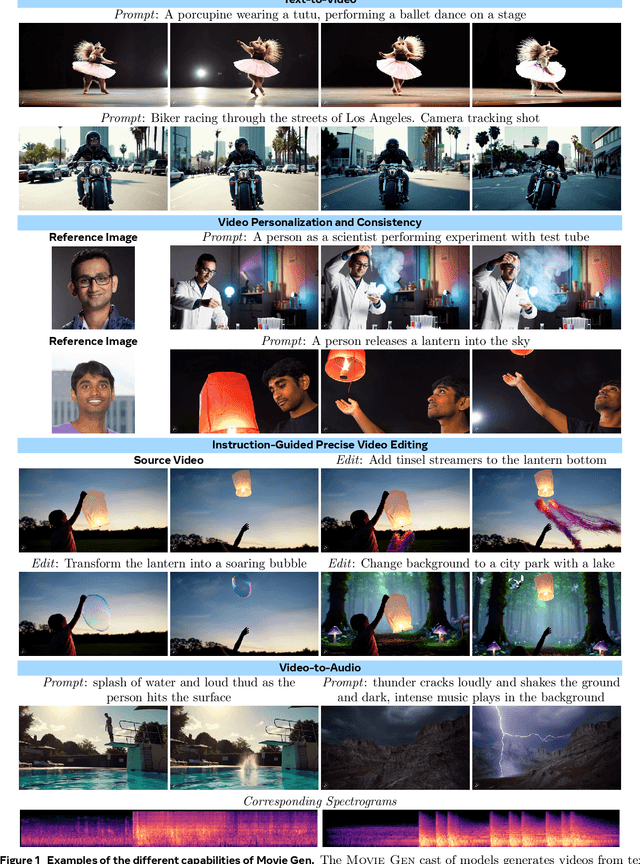

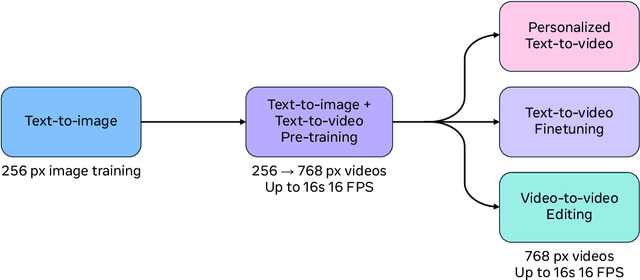
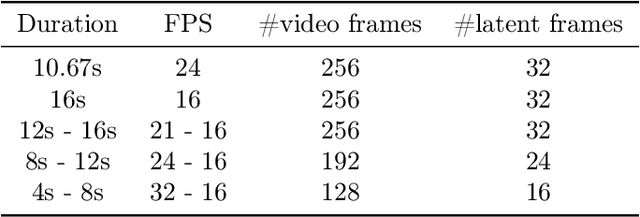
Abstract:We present Movie Gen, a cast of foundation models that generates high-quality, 1080p HD videos with different aspect ratios and synchronized audio. We also show additional capabilities such as precise instruction-based video editing and generation of personalized videos based on a user's image. Our models set a new state-of-the-art on multiple tasks: text-to-video synthesis, video personalization, video editing, video-to-audio generation, and text-to-audio generation. Our largest video generation model is a 30B parameter transformer trained with a maximum context length of 73K video tokens, corresponding to a generated video of 16 seconds at 16 frames-per-second. We show multiple technical innovations and simplifications on the architecture, latent spaces, training objectives and recipes, data curation, evaluation protocols, parallelization techniques, and inference optimizations that allow us to reap the benefits of scaling pre-training data, model size, and training compute for training large scale media generation models. We hope this paper helps the research community to accelerate progress and innovation in media generation models. All videos from this paper are available at https://go.fb.me/MovieGenResearchVideos.
Autoregressive Speech Synthesis without Vector Quantization
Jul 11, 2024Abstract:We present MELLE, a novel continuous-valued tokens based language modeling approach for text to speech synthesis (TTS). MELLE autoregressively generates continuous mel-spectrogram frames directly from text condition, bypassing the need for vector quantization, which are originally designed for audio compression and sacrifice fidelity compared to mel-spectrograms. Specifically, (i) instead of cross-entropy loss, we apply regression loss with a proposed spectrogram flux loss function to model the probability distribution of the continuous-valued tokens. (ii) we have incorporated variational inference into MELLE to facilitate sampling mechanisms, thereby enhancing the output diversity and model robustness. Experiments demonstrate that, compared to the two-stage codec language models VALL-E and its variants, the single-stage MELLE mitigates robustness issues by avoiding the inherent flaws of sampling discrete codes, achieves superior performance across multiple metrics, and, most importantly, offers a more streamlined paradigm. See https://aka.ms/melle for demos of our work.
VALL-E R: Robust and Efficient Zero-Shot Text-to-Speech Synthesis via Monotonic Alignment
Jun 12, 2024Abstract:With the help of discrete neural audio codecs, large language models (LLM) have increasingly been recognized as a promising methodology for zero-shot Text-to-Speech (TTS) synthesis. However, sampling based decoding strategies bring astonishing diversity to generation, but also pose robustness issues such as typos, omissions and repetition. In addition, the high sampling rate of audio also brings huge computational overhead to the inference process of autoregression. To address these issues, we propose VALL-E R, a robust and efficient zero-shot TTS system, building upon the foundation of VALL-E. Specifically, we introduce a phoneme monotonic alignment strategy to strengthen the connection between phonemes and acoustic sequence, ensuring a more precise alignment by constraining the acoustic tokens to match their associated phonemes. Furthermore, we employ a codec-merging approach to downsample the discrete codes in shallow quantization layer, thereby accelerating the decoding speed while preserving the high quality of speech output. Benefiting from these strategies, VALL-E R obtains controllablity over phonemes and demonstrates its strong robustness by approaching the WER of ground truth. In addition, it requires fewer autoregressive steps, with over 60% time reduction during inference. This research has the potential to be applied to meaningful projects, including the creation of speech for those affected by aphasia. Audio samples will be available at: https://aka.ms/valler.
VALL-E 2: Neural Codec Language Models are Human Parity Zero-Shot Text to Speech Synthesizers
Jun 08, 2024Abstract:This paper introduces VALL-E 2, the latest advancement in neural codec language models that marks a milestone in zero-shot text-to-speech synthesis (TTS), achieving human parity for the first time. Based on its predecessor, VALL-E, the new iteration introduces two significant enhancements: Repetition Aware Sampling refines the original nucleus sampling process by accounting for token repetition in the decoding history. It not only stabilizes the decoding but also circumvents the infinite loop issue. Grouped Code Modeling organizes codec codes into groups to effectively shorten the sequence length, which not only boosts inference speed but also addresses the challenges of long sequence modeling. Our experiments on the LibriSpeech and VCTK datasets show that VALL-E 2 surpasses previous systems in speech robustness, naturalness, and speaker similarity. It is the first of its kind to reach human parity on these benchmarks. Moreover, VALL-E 2 consistently synthesizes high-quality speech, even for sentences that are traditionally challenging due to their complexity or repetitive phrases. The advantages of this work could contribute to valuable endeavors, such as generating speech for individuals with aphasia or people with amyotrophic lateral sclerosis. Demos of VALL-E 2 will be posted to https://aka.ms/valle2.
WavLLM: Towards Robust and Adaptive Speech Large Language Model
Mar 31, 2024Abstract:The recent advancements in large language models (LLMs) have revolutionized the field of natural language processing, progressively broadening their scope to multimodal perception and generation. However, effectively integrating listening capabilities into LLMs poses significant challenges, particularly with respect to generalizing across varied contexts and executing complex auditory tasks. In this work, we introduce WavLLM, a robust and adaptive speech large language model with dual encoders, and a prompt-aware LoRA weight adapter, optimized by a two-stage curriculum learning approach. Leveraging dual encoders, we decouple different types of speech information, utilizing a Whisper encoder to process the semantic content of speech, and a WavLM encoder to capture the unique characteristics of the speaker's identity. Within the curriculum learning framework, WavLLM first builds its foundational capabilities by optimizing on mixed elementary single tasks, followed by advanced multi-task training on more complex tasks such as combinations of the elementary tasks. To enhance the flexibility and adherence to different tasks and instructions, a prompt-aware LoRA weight adapter is introduced in the second advanced multi-task training stage. We validate the proposed model on universal speech benchmarks including tasks such as ASR, ST, SV, ER, and also apply it to specialized datasets like Gaokao English listening comprehension set for SQA, and speech Chain-of-Thought (CoT) evaluation set. Experiments demonstrate that the proposed model achieves state-of-the-art performance across a range of speech tasks on the same model size, exhibiting robust generalization capabilities in executing complex tasks using CoT approach. Furthermore, our model successfully completes Gaokao tasks without specialized training. The codes, models, audio, and Gaokao evaluation set can be accessed at \url{aka.ms/wavllm}.
SpeechX: Neural Codec Language Model as a Versatile Speech Transformer
Aug 14, 2023Abstract:Recent advancements in generative speech models based on audio-text prompts have enabled remarkable innovations like high-quality zero-shot text-to-speech. However, existing models still face limitations in handling diverse audio-text speech generation tasks involving transforming input speech and processing audio captured in adverse acoustic conditions. This paper introduces SpeechX, a versatile speech generation model capable of zero-shot TTS and various speech transformation tasks, dealing with both clean and noisy signals. SpeechX combines neural codec language modeling with multi-task learning using task-dependent prompting, enabling unified and extensible modeling and providing a consistent way for leveraging textual input in speech enhancement and transformation tasks. Experimental results show SpeechX's efficacy in various tasks, including zero-shot TTS, noise suppression, target speaker extraction, speech removal, and speech editing with or without background noise, achieving comparable or superior performance to specialized models across tasks. See https://aka.ms/speechx for demo samples.
Speak Foreign Languages with Your Own Voice: Cross-Lingual Neural Codec Language Modeling
Mar 07, 2023Abstract:We propose a cross-lingual neural codec language model, VALL-E X, for cross-lingual speech synthesis. Specifically, we extend VALL-E and train a multi-lingual conditional codec language model to predict the acoustic token sequences of the target language speech by using both the source language speech and the target language text as prompts. VALL-E X inherits strong in-context learning capabilities and can be applied for zero-shot cross-lingual text-to-speech synthesis and zero-shot speech-to-speech translation tasks. Experimental results show that it can generate high-quality speech in the target language via just one speech utterance in the source language as a prompt while preserving the unseen speaker's voice, emotion, and acoustic environment. Moreover, VALL-E X effectively alleviates the foreign accent problems, which can be controlled by a language ID. Audio samples are available at \url{https://aka.ms/vallex}.
Neural Codec Language Models are Zero-Shot Text to Speech Synthesizers
Jan 05, 2023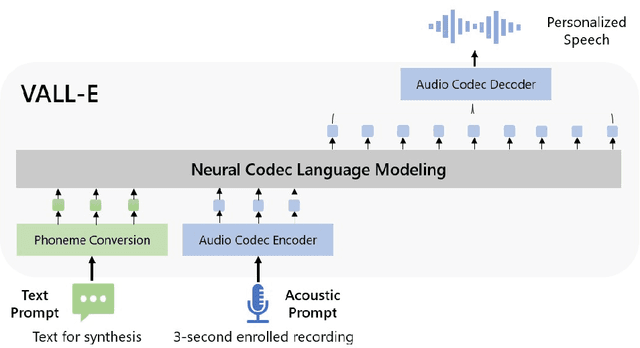


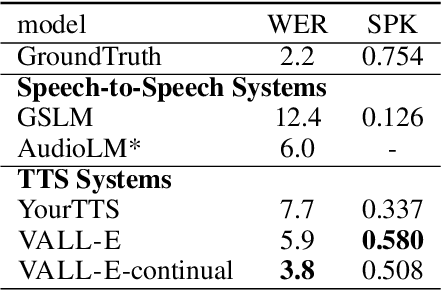
Abstract:We introduce a language modeling approach for text to speech synthesis (TTS). Specifically, we train a neural codec language model (called Vall-E) using discrete codes derived from an off-the-shelf neural audio codec model, and regard TTS as a conditional language modeling task rather than continuous signal regression as in previous work. During the pre-training stage, we scale up the TTS training data to 60K hours of English speech which is hundreds of times larger than existing systems. Vall-E emerges in-context learning capabilities and can be used to synthesize high-quality personalized speech with only a 3-second enrolled recording of an unseen speaker as an acoustic prompt. Experiment results show that Vall-E significantly outperforms the state-of-the-art zero-shot TTS system in terms of speech naturalness and speaker similarity. In addition, we find Vall-E could preserve the speaker's emotion and acoustic environment of the acoustic prompt in synthesis. See https://aka.ms/valle for demos of our work.
BEATs: Audio Pre-Training with Acoustic Tokenizers
Dec 18, 2022Abstract:The massive growth of self-supervised learning (SSL) has been witnessed in language, vision, speech, and audio domains over the past few years. While discrete label prediction is widely adopted for other modalities, the state-of-the-art audio SSL models still employ reconstruction loss for pre-training. Compared with reconstruction loss, semantic-rich discrete label prediction encourages the SSL model to abstract the high-level audio semantics and discard the redundant details as in human perception. However, a semantic-rich acoustic tokenizer for general audio pre-training is usually not straightforward to obtain, due to the continuous property of audio and unavailable phoneme sequences like speech. To tackle this challenge, we propose BEATs, an iterative audio pre-training framework to learn Bidirectional Encoder representation from Audio Transformers, where an acoustic tokenizer and an audio SSL model are optimized by iterations. In the first iteration, we use random projection as the acoustic tokenizer to train an audio SSL model in a mask and label prediction manner. Then, we train an acoustic tokenizer for the next iteration by distilling the semantic knowledge from the pre-trained or fine-tuned audio SSL model. The iteration is repeated with the hope of mutual promotion of the acoustic tokenizer and audio SSL model. The experimental results demonstrate our acoustic tokenizers can generate discrete labels with rich audio semantics and our audio SSL models achieve state-of-the-art results across various audio classification benchmarks, even outperforming previous models that use more training data and model parameters significantly. Specifically, we set a new state-of-the-art mAP 50.6% on AudioSet-2M for audio-only models without using any external data, and 98.1% accuracy on ESC-50. The code and pre-trained models are available at https://aka.ms/beats.
 Add to Chrome
Add to Chrome Add to Firefox
Add to Firefox Add to Edge
Add to Edge